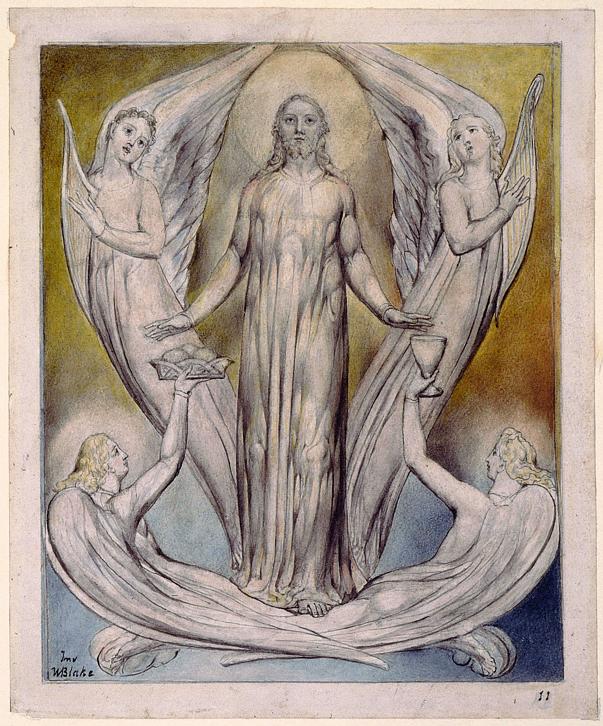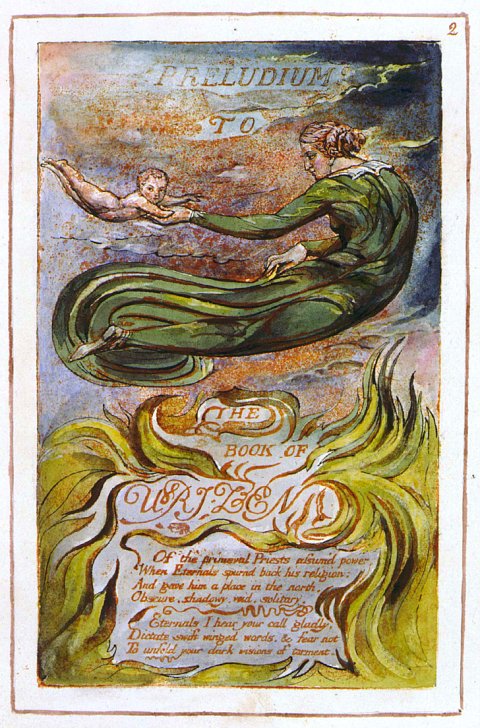Quote from
Blake's Sublime Allegory, chapter by Joseph Anthony Wittreich, Jr.,
Opening the Seals, Page 30:
"Each prophet is both creator of his visions and interpreter of them; and every subsequent repeats the pattern but, in the process, becomes both the interpreter of his own visions and of the visions of his predecessors...The Apocalypse is simultaneously an interpretation and a prophecy; by way of repeating all previous prophecies it comments on them, but it introduces a series of seven new visions, each of which interprets the one it supersedes until in the final vision all things burst into clarity....
Blake's epics turn to St. John, the last great prophet in Scripture, and to John Milton, the last great prophet in the epic mode; and then they in turn, for their structural model, to the culminating vision of each prophet: Milton's vision of paradise regained and John's of apocalypse. In these prophecies, 'The summe of Religion is shewed,' and it is Blake's task to reveal the essence of these visions, which commentators on Revelation understood as 'allegories,' penetrable by only the initiated, and which eighteenth-century commentators on Milton seemed not have understood at all."
Wittreich explores the poetry of John Milton and William Blake within the literary forms of the epic and prophecy. In this passage he explains characteristics of prophecy which are exhibited in both Blake and Milton. In the light of this explanation we see Blake as a prophet building on his predecessor Milton. Specifically we can explore Blake's illustrations to
Paradise Regained as prophetic commentary on Milton's poem seen as prophecy. Milton in turn was building on the prophetic vision incorporated in the biblical account of the testing of Jesus prior to the inception of his ministry.
So two things we need to be looking for in the images are how Milton explored and commented on and expanded the brief accounts of temptation of Jesus by the devil in Matthew and Luke; and how Blake commented on Milton's vision and supplemented it with his own vision which complemented that of Milton. The Biblical vision is incorporated and transformed by both Milton and Blake.
Blake's second image of his illustrations to
Paradise Regained responds to these words in Matthew:
Matthew 4
[
1] Then was Jesus led up of the Spirit into the wilderness to be tempted of the devil.
[
2] And when he had fasted forty days and forty nights, he was afterward an hungred.
[
3] And when the tempter came to him, he said, If thou be the Son of God, command that these stones be made bread.
[
4] But he answered and said, It is written, Man shall not live by bread alone, but by every word that proceedeth out of the mouth of God.
And these words in
Paradise Regained:
"But now an aged man in rural weeds,
Following, as seemed, the quest of some stray eye,
Or withered sticks to gather,
...
then with words thus uttered spake: -- [320]
"Sir, what ill chance hath brought thee to this place,
...
To whom the Son of God: -- "Who brought me hither
Will bring me hence; no other guide I seek."
"By miracle he may," replied the swain;
"What other way I see not; for we here
Live on tough roots and stubs, to thirst inured
More than the camel, and to drink go far -- [340]
Men to much misery and hardship born.
But, if thou be the Son of God, command
That out of these hard stones be made thee bread;
So shalt thou save thyself, and us relieve
With food, whereof we wretched seldom taste."
He ended, and the Son of God replied: --
"Think'st thou such force in bread? Is it not written
(For I discern thee other than thou seem'st),
Man lives not by bread only, but each word
Proceeding from the mouth of God, who fed [350]
Our fathers here with manna? In the Mount
Moses was forty days, nor eat nor drank;
And forty days Eliah without food
Wandered this barren waste; the same I now.
Why dost thou, then, suggest to me distrust
Knowing who I am, as I know who thou art?"
Matthew, Milton and Blake focus attention on the essence of the scene that Jesus quotes in scripture indicating that: "Man lives not by bread only, but each word Proceeding from the mouth of God." Blake pictures Jesus pointing upwards to the heavens from which the word of God issues. By pointing to his own mouth as well Jesus indicates that the word of God is spoken by him also. In contrast the devil in disguise points downward suggesting that the words from his mouth come from below.

The vision which Blake adds to the Bible and Milton is less obvious. The position of Christ's body, except for the arms, is an echo of the position of
Milton on the title page of
Milton associating with one another the two characters and the events which will be portrayed. Both figures are poised to move forward which Blake emphasizes by the position of the right foot, a position which is repeated at critical times in Blake's imagery. Blake is associating the whole of his book
Milton and the place in his mythology which it represents with the critical point in the life of Jesus portrayed in Matthew and in
Paradise Regained.
The disguise that the devil has assumed in this picture resembles images Blake most commonly uses for Urizen and Jehovah. Blake is drawing the viewer into connecting characters and situations which reappear throughout his myth with the temptation of Jesus.
The Bible and Milton's writings were stimuli that provoked Blake to continue to express his imagination in his unique art.
.
















_MET_DT5424.jpg)


